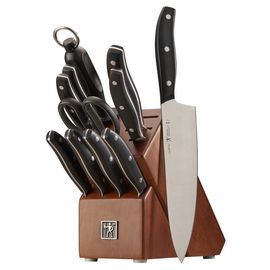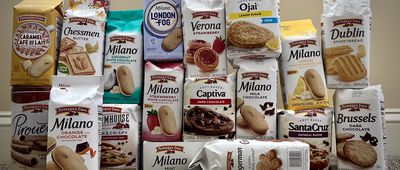Best Cheap Kitchen Knives
Professional chefs who need professional-grade kitchen knives rely on internationally acclaimed knives that cost hundreds or even thousands of dollars. But if you're a regular home cook shopping for the best knives to use in your kitchen, there's no reason to spend big on a cutlery set. According to scores of reviews by consumers, the best cheap kitchen knives feel good in the hand and cut cleanly and easily.
Our Top Pick


J.A. Henckels International Definition 12-Piece Review
Best Kitchen Knife Set Under $100 Overall
Included: 5" santoku knife | 8" chef's knife | 3" paring knife | 5" serrated utility knife | 8" bread knife | 4 steak knives | scissors | sharpening steel | wood block
Pros:
- Very good starter set from well-respected brand.
- Knives have a nice weight and balance that feels good in the hand, users say, and the blades can cut through hard vegetables without a huge amount of pressure.
- Stamped, high-carbon stainless steel blades have relatively thin edges.
- Even the kitchen shears in this set are high-quality; they're very sharp and capable of cutting through bones, according to reviews.
- Dishwasher-safe; owners don't complain of rusting.
- Limited lifetime warranty.
Cons:
- Made in China; some reviewers suggest that the knives are not as strong and durable as their German counterparts.
- A handful of buyers say the blades were not sharp out of the box.
Takeaway: These are classic, full tang, triple-riveted knives (with black polymer handle) from a classic company. A majority of consumer reviews give this J.A. Henckels knife set high ratings, and most owners are more than pleased with the quality-to-price ratio. They get most of the basic pieces needed for everyday cooking tasks -- including a set of shears that some say are the star of the set -- in a brand-name block they feel proud to display on their countertops.

Chicago Cutlery Elston 16-Piece Review
Best Stainless Steel Kitchen Knives Under $100
Included: 8" chef's knife | two 3.25" paring knives | 4.75" utility knife | 6.75" bread knife | 8 steak knives | scissors | sharpening steel | natural wood block
Pros:
- Users say these knives are very sharp and hold their edge for a long time.
- High-carbon stainless steel blades are forged, not stamped -- difficult to find in this price range.
- "Elegant" look, with stainless handles that are curved to fit the hand well.
- Seamless handles keep water and dirt from collecting in nooks and crannies.
- Knives are fairly lightweight but have a sturdy, "quality" feel, according to reviews.
- Full lifetime warranty.
Cons:
- Some mentions of occasional rust; hand wash only.
- Steak knives don't have a serrated edge and don't stay sharp as long as serrated knives do.
- A few owners wish there were more large knives included.
Takeaway: These knives have full-tang construction for stability and stainless handles that are ergonomically shaped to fit the hand and be well-balanced. The forged blades hold a sharp edge and take to sharpening well. Reviews from hundreds of happy owners say the Chicago Cutlery Elston 16-Piece set is an excellent purchase: The knives look great in any kitchen, perform better than expected for the price, and stand up well over time.

Ginsu Chikara Series 8-Piece (07108DS) Review
Best Japanese Knife Set Under $100
Included: 7" santoku knife | 8" chef's knife | 3.5" paring knife | 5" utility knife | 5" serrated utility knife | scissors | sharpening steel | bamboo block
Pros:
- Made from forged Japanese steel, the blades are extremely sharp and stay sharp for a long time; some people say they haven't had to sharpen them in over a year.
- Knives slice easily through everything from tomatoes to bones on chicken wings.
- Thin enough blade for precision cutting.
- Polymer-covered, full-tang, rounded handles are very nicely weighted; most users find them comfortable to hold.
- Nearly seamless, non-riveted design helps keep water and dirt out of crevices.
- Limited lifetime warranty.
Cons:
- Some mentions of knife tips breaking when dropped.
- Users who've owned Ginsu knives before suggest these newer models are lower quality than previous versions.
- Shears may be slightly disappointing; a few reports of breakage.
- Reports of rusting; hand wash only.
- No steak knives.
Takeaway: With stainless steel blades that are forged rather than stamped, these durable knives of '70s fame stay sharp for a long time, as long as they are frequently honed. Potential purchasers should be aware that, although they are "Japanese style," this collection is actually made in China and quality control may not be what it used to be. Nonetheless, thousands of purchasers say the Ginsu Chikara Series 8-Piece set is a great value for the price.

Cuisinart Graphix Collection 15-Piece (C77SS-15P) Review
Good Stainless Steel Kitchen Knives Under $100
Included: 7" santoku knife | 8" chef's knife | 8" slicing knife | 3.5" paring knife | 2.75" bird's beak paring knife | 5.5" serrated utility knife | 6 steak knives | scissors | sharpening steel | wood block (black finish)
Pros:
- High-carbon stainless steel blades start sharp and hold their edge well, according to reviews.
- Stainless steel handles are lightweight, reducing fatigue; users say the ergonomic design feels good in the hand.
- Textured handles to prevent slipping.
- Lifetime limited warranty.
Cons:
- Some owners report rusting, particularly on the handles.
- Several reviewers say the steak knives feel chintzy and don't cut well; only part of the blade is serrated.
Takeaway: With lightweight, hollow stainless steel handles with a herringbone-textured grip surface, the Cuisinart Graphix Collection 15-Piece knife set is sleek and coordinates well with stainless appliances. The solid, one-piece construction is a boon to people who have had wooden or plastic handles crack or separate from the tang. While most of the knives are said to be quite good, users looking for premium steak knives might want to steer clear of this set. And be sure to follow the care instructions to help prevent rusting.

Pure Komachi 2 9-Piece Review
Good Colorful Knife Set Under $100
Included: 6.5" hollow ground santoku knife | 8" chef's knife | 3.5" paring knife | 4" tomato knife | 4" citrus knife | 6" multi-utility knife | 8" bread knife | 6" bagel/sandwich knife | acrylic block (clear)
Pros:
- Stainless steel, high-carbon resin-coated blades stay sharp for a very long time.
- Bright colors set in a clear block add personality to the kitchen counter.
- Color coding helps prevent cross contamination.
- Coating makes the knives easier to clean and virtually rust-proof.
- Lightweight and comfortable to hold.
Cons:
- Knife block is large and some say it looks cheap.
- No steak knives.
- Not dishwasher-safe; users warn that the color wears if the knives aren't hand washed.
- 5-year warranty is relatively short.
Takeaway: The colorful Pure Komachi 2 9-Piece set is made from stainless steel with a resin coating to help knives glide through foods while repelling stains, water, and rust. These knives may look fun, but they're no joke: Many satisfied users say they boast seriously sharp blades and hold up very well over time. The manufacturer claims that the open design of the storage block is meant to allow greater air circulation and prevent bacteria growth, although many users complain that it takes up way too much counter space. Some suggest putting the knives on a magnetic strip instead. (For consumers disappointed by the lack of steak knives, a set that includes them can sometimes be found on Amazon; the set can also be purchased without the block.)

Sabatier Edgekeeper Pro 12-Piece Review
Good Self-Sharpening Kitchen Knives Under $100
Included: 8" chef's knife | 5" chef's knife with kullens | 8" slicer knife | 3.5" paring knife | 4.5" fine-edge utility knife | 6 steak knives | wood block (black finish)
Pros:
- Forged knives with full-tang blades made from high-carbon stainless steel.
- Users say blades come very sharp out of the box, and the block has built-in (ceramic) sharpeners.
- Knives have good heft and balance, according to reviews.
- Lifetime limited warranty.
Cons:
- No serrated knives.
- Steak knife slots don't have sharpeners (but they can be sharpened in other slots).
- A couple of reports of knives chipping; some mentions of rust (though relatively few).
- Some owners posting on Amazon say a plastic storage block came with their sets.
Takeaway: An affordable offering from a renowned French brand, the Sabatier Edgekeeper Pro 12-Piece set has a look and feel that belies its low cost. These knives cut through meats and vegetables with ease, and would be a solid purchase even without the self-sharpening block (which gets mixed reviews for effectiveness). The biggest disappointment users seem to have is that this set doesn't feel quite complete: There's no serrated knife or shears.

Oster Baldwyn 22-Piece (70562.22) Review
Quantity Over Quality
Included: 6.5" santoku | 8" and 6" chef knives | 8" carving knife | 6" fork | 6" cleaver | 3.5" paring knife | 3" bird's beak paring knife | 6" utility knife | 8" bread knife | 6" boning knife | 8 steak knives | scissors | sharpening steel | wood block (black finish)
Pros:
- Many really like the sleek, fully "stainless" look.
- Lightweight with hollow handles, easy to hold.
- Knives cut well, stainless steel blades are sharp and stay sharp for a few months.
- Block swivels on rotating base for more convenient access.
- Limited lifetime warranty.
Cons:
- Have to be washed immediately or they rust.
- Not one piece; some users complain of loose handles.
- Hollow handles hold water.
- Scissors are said to break easily; a few reports of the block cracking.
Takeaway: While it's nice to have so many items included in an inexpensive knife block set, quality is sometimes sacrificed in favor of quantity. Consumers who purchased the Oster Baldwyn 22-Piece cutlery set say it looks very stylish (at least at first) and the knives are plenty sharp (at least at first), but many were dismayed by the speed of rusting -- in part because the hollow handles are not thoroughly sealed so water gets trapped inside. Also, although the light weight of these knives was a plus for many, others say that they just feel cheaply made.

Farberware 15-Piece (5089000) Review
Not the Best Buy From This Brand
Included: 7" santoku | 8" chef knife | 8" slicer knife | 3.5" paring knife | 5.5" serrated utility knife | 8" bread knife | 6 steak knives | scissors | sharpening steel | wood block (black finish)
Pros:
- Very attractive, modern-looking set that owners say complements kitchens and appliances.
- Stainless steel handle fits in the hand well, comfortable to use.
- Knives are fairly sharp out of the box and sharpen easily.
- Limited lifetime warranty.
Cons:
- Handles are not bonded well to knives, so water can get in.
- Tang does not run all the way through, black interior of handle is made of plastic.
- Some users complain of broken knives.
- Numerous reports of rusting after only minimal use, even with proper care.
Takeaway: The biggest issue consumers have with this Farberware 15-Piece stamped stainless steel set is that the tang is made of plastic, which causes several problems. Water ends up seeping into the handles, and the tang bends or breaks. Many also complain that it's nearly impossible to keep this set free from rust. While Farberware has been known for making some quality products, several users say this set does not reflect well on the brand.




















